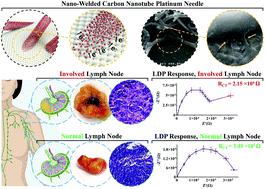当前位置:
X-MOL 学术
›
Biomater. Sci.
›
论文详情
Our official English website, www.x-mol.net, welcomes your
feedback! (Note: you will need to create a separate account there.)
The design and fabrication of nanoengineered platinum needles with laser welded carbon nanotubes (CNTs) for the electrochemical biosensing of cancer lymph nodes
Biomaterials Science ( IF 5.8 ) Pub Date : 2021-08-06 , DOI: 10.1039/d1bm00875g Ashkan Zandi 1, 2 , Zahra Davari Sh 1 , Fatemeh Shojaeian 1, 3 , S M Sadegh Mousavi-Kiasary 1 , Fereshteh Abbasvandi 1, 4 , Afsoon Zandi 5 , Ali Gilani 1 , Zohre Saghafi 1 , Yasin Kordehlachin 1 , Amir Mamdouh 1 , Seyyed Hossein Miraghaie 1 , Meisam Hoseinyazdi 6 , Mohammad Ali Khayamian 1, 2 , Robab Anbiaee 7 , Mohammad Faranoush 8, 9 , Mohammad Abdolahad 1, 2, 10
Biomaterials Science ( IF 5.8 ) Pub Date : 2021-08-06 , DOI: 10.1039/d1bm00875g Ashkan Zandi 1, 2 , Zahra Davari Sh 1 , Fatemeh Shojaeian 1, 3 , S M Sadegh Mousavi-Kiasary 1 , Fereshteh Abbasvandi 1, 4 , Afsoon Zandi 5 , Ali Gilani 1 , Zohre Saghafi 1 , Yasin Kordehlachin 1 , Amir Mamdouh 1 , Seyyed Hossein Miraghaie 1 , Meisam Hoseinyazdi 6 , Mohammad Ali Khayamian 1, 2 , Robab Anbiaee 7 , Mohammad Faranoush 8, 9 , Mohammad Abdolahad 1, 2, 10
Affiliation

|
A new biosensor for detecting cancer involved sentinel lymph nodes has been developed via the electrochemical tracing of fatty acid oxidation as a distinct metabolism of malignant cells invading lymph nodes (LNs). The system included integrated platinum needle electrodes that were decorated by carbon nanotubes (as hydrophobic agents) through laser-assisted nanowelding. It was applied to record the dielectric spectroscopy data from LN contents via electrochemical impedance spectroscopy. The system was applied for dielectric spectroscopy of LN contents via electrochemical impedance approach. The reduced lipid content of involved LNs, due to fat metabolism by invasive cancer cells, would decrease the charge transfer resistance (RCT) of the LNs with respect to their normal counterparts. Multi-walled carbon nanotubes (MWCNTs) with superhydrophobic properties were used to enhance the interaction of Pt needle electrodes with the lipidic contents of lymph nodes. This is the first time that a fatty acid metabolism-based sensing approach has been introduced to detect involved LNs. Moreover, a novel electrode decorating method was applied to enhance the interfacial contact of this lipid detection probe (LDP). In order to avoid doubt about the biocompatibility of ferrocyanide, [Fe(CN)6]4− and ferricyanide, [Fe(CN)6]3−, a biocompatible injectable metal ion-based material, ferric carboxymaltose, was selected and applied as the electrolyte for the first time. Rabbit LNs were tested using the LDP in the animal model phase. The system was then used in vitro on 122 dissected human LNs in the operating room. Calibration of the results showed an excellent match between the dielectric response of the LDP (known as charge transfer resistance (RCT)) and the final pathological diagnoses. The LDP may have a promising future after further clinical investigations for intra-operative distinction between normal and cancerous LNs.
中文翻译:

用于癌症淋巴结电化学生物传感的激光焊接碳纳米管 (CNT) 纳米工程铂针的设计和制造
已经通过脂肪酸氧化的电化学追踪开发了一种用于检测涉及前哨淋巴结的癌症的新生物传感器,作为侵袭淋巴结 (LNs) 的恶性细胞的独特代谢。该系统包括通过激光辅助纳米焊接由碳纳米管(作为疏水剂)装饰的集成铂针电极。它用于通过电化学阻抗谱记录 LN 含量的介电谱数据。该系统通过 电化学阻抗方法应用于 LN 含量的介电光谱分析 。由于侵袭性癌细胞的脂肪代谢,所涉及的 LN 的脂质含量降低,会降低电荷转移电阻(R CT) 的 LN 相对于其正常对应方。具有超疏水特性的多壁碳纳米管 (MWCNT) 用于增强 Pt 针电极与淋巴结脂质含量的相互作用。这是首次引入基于脂肪酸代谢的传感方法来检测所涉及的 LN。此外,还应用了一种新的电极装饰方法来增强这种脂质检测探针 (LDP) 的界面接触。为了避免对亚铁氰化物[Fe(CN) 6 ] 4-和铁氰化物[Fe(CN) 6 ] 3-的生物相容性产生怀疑首次选择并应用了一种生物相容性可注射金属离子基材料羧基麦芽糖铁作为电解质。在动物模型阶段使用 LDP 测试兔 LN。然后将该系统体外用于手术室中 122 个解剖的人类 LN。结果的校准显示 LDP 的介电响应(称为电荷转移电阻 ( R CT ))与最终病理诊断之间非常匹配。在对正常和癌变 LN 之间的术中区分进行进一步临床研究后,LDP 可能会有一个充满希望的未来。
更新日期:2021-08-07
中文翻译:

用于癌症淋巴结电化学生物传感的激光焊接碳纳米管 (CNT) 纳米工程铂针的设计和制造
已经通过脂肪酸氧化的电化学追踪开发了一种用于检测涉及前哨淋巴结的癌症的新生物传感器,作为侵袭淋巴结 (LNs) 的恶性细胞的独特代谢。该系统包括通过激光辅助纳米焊接由碳纳米管(作为疏水剂)装饰的集成铂针电极。它用于通过电化学阻抗谱记录 LN 含量的介电谱数据。该系统通过 电化学阻抗方法应用于 LN 含量的介电光谱分析 。由于侵袭性癌细胞的脂肪代谢,所涉及的 LN 的脂质含量降低,会降低电荷转移电阻(R CT) 的 LN 相对于其正常对应方。具有超疏水特性的多壁碳纳米管 (MWCNT) 用于增强 Pt 针电极与淋巴结脂质含量的相互作用。这是首次引入基于脂肪酸代谢的传感方法来检测所涉及的 LN。此外,还应用了一种新的电极装饰方法来增强这种脂质检测探针 (LDP) 的界面接触。为了避免对亚铁氰化物[Fe(CN) 6 ] 4-和铁氰化物[Fe(CN) 6 ] 3-的生物相容性产生怀疑首次选择并应用了一种生物相容性可注射金属离子基材料羧基麦芽糖铁作为电解质。在动物模型阶段使用 LDP 测试兔 LN。然后将该系统体外用于手术室中 122 个解剖的人类 LN。结果的校准显示 LDP 的介电响应(称为电荷转移电阻 ( R CT ))与最终病理诊断之间非常匹配。在对正常和癌变 LN 之间的术中区分进行进一步临床研究后,LDP 可能会有一个充满希望的未来。











































 京公网安备 11010802027423号
京公网安备 11010802027423号